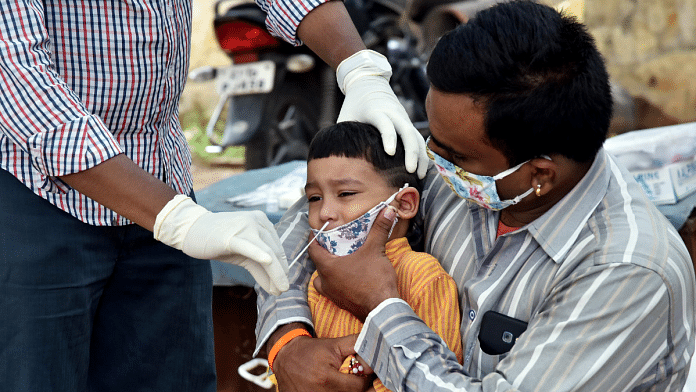New Delhi: The Union health ministry’s National Centre for Disease Control (NCDC) — the nodal agency responsible for the surveillance, prevention and control of communicable and non-communicable diseases in the country — has asked for a report from southern states that are witnessing a surge in an unknown febrile illness (fever), especially among children, ThePrint has learnt.
A senior official in the NCDC told ThePrint that they have received reports of a large number of cases of fever with respiratory symptoms from Telangana, Kerala, Karnataka and Tamil Nadu. However, the patients are testing negative for viral infections such as Covid-19, swine flu or those caused by adenoviruses.
“Also, the cases are largely being seen in children and adults with comorbidities even though most cases are getting resolved on their own,” the official said.
“We have asked the affected states for detailed reports on the outbreak and will soon analyse the data,” the official added.
Speaking to ThePrint, doctors described the symptoms of the unknown fever, which they said is a “non-dengue kind of viral infection” that affects mostly children and adults with comorbidities. While they clarified that there has been no life-threatening case so far, there appears to be no uniform line of treatment as of now.
Dilip Gude, senior consultant physician with Yashoda Hospitals, Hyderabad, said blood tests may show normal results in most cases, but the illness seems to be a kind of flu that is more severe than is usual in this season.
According to Dr Anantha Krishnan, internal medicine specialist and diabetologist with Prashanth Hospitals, Chennai, the disease is self-limiting and does not require antibiotics or antivirals. However, he added, it is important to rule out other possible infections and to maintain good hydration and take rest.
Data on the outbreak is not yet available on the Integrated Disease Surveillance Programme (IDSP), which is maintained by the NCDC and publishes a weekly report on disease outbreaks in the country.
ThePrint reached NCDC director Dr Atul Goel for comment via multiple phone calls, but failed to get a response. The report will be updated once a response is received.
Signs and symptoms
According to Gude, there is a new type of acute febrile illness that has reached almost epidemic proportions in most south Indian cities, as well as some other parts of the country.
The common symptoms that he observed in patients are a fever of about 101°F, cough with scanty sputum, nose block, running nose, severe joint and muscle pain, headache, heavy and/or watery eyes, cramps, and calf pain.
Gude said that, around 4-5 days into the illness, a blood test may show a decrease in both white blood cells and platelets (bicytopenia).
“Dengue test’s antigen may typically be negative, so it looks like a non-dengue kind of viral fever that has gripped almost the whole of south India,” he said. “There are instances of leptospirosis and/or malaria that coexist at the same time with this illness, and adequate oral, and if required, intravenous hydration remains the mainstay of therapy.”
He added that doxycycline and oseltamivir are also important treatment options along with antipyretic measures.
According to Dr Krishnan, the disease initially affects mainly the extreme age groups and then spreads to the rest of the population.
Respiratory droplets and aerosols are a common modality of the spread of the infection, he said, adding that common symptoms include fever, itchy throat, eye irritation, eye redness, and cough.
“The disease is predominantly self-limiting and resolves in 5-7 days,” he said, emphasising that no life-threatening cases have been reported so far. However, he added that it was important to rule out other possible infections such as dengue, malaria, swine flu, and Covid, as they have similar clinical features.
He advised good hydration, rest and isolation for most patients for recovery, and said antibiotics, antivirals, or steroids do not have any role in treating these patients.
(Edited by Richa Mishra)
Also Read: Influenza subtype A H3N2 major cause behind respiratory illness flare-up across India, says ICMR



